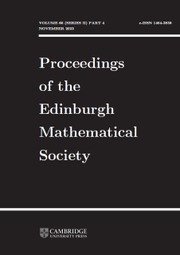No CrossRef data available.
Article contents
Kostant’s problem for parabolic Verma modules
Published online by Cambridge University Press: 27 January 2025
Abstract
We give a complete combinatorial classification of the parabolic Verma modules in the principal block of the parabolic category  $\mathcal{O}$ associated with a minimal or a maximal parabolic subalgebra of the special linear Lie algebra for which the answer to Kostant’s problem is positive.
$\mathcal{O}$ associated with a minimal or a maximal parabolic subalgebra of the special linear Lie algebra for which the answer to Kostant’s problem is positive.
Keywords
MSC classification
Information
- Type
- Research Article
- Information
- Copyright
- © The Author(s), 2025. Published by Cambridge University Press on Behalf of The Edinburgh Mathematical Society.
References
Andersen, H. and Stroppel, C., Twisting functors on  $\mathcal{O}$, Represent. Theory 7(26) (2003), 681–699.CrossRefGoogle Scholar
$\mathcal{O}$, Represent. Theory 7(26) (2003), 681–699.CrossRefGoogle Scholar
Beilinson, A. and Bernstein, J., Localisation de  $\mathfrak{g}$-modules, C. R. Acad. Sci. Paris Ser. I Math. 292(1) (1981), 15–18.Google Scholar
$\mathfrak{g}$-modules, C. R. Acad. Sci. Paris Ser. I Math. 292(1) (1981), 15–18.Google Scholar
Bernstein, I.; Gelfand, I. and Gelfand, S., A certain category of  $\mathfrak{g}$-modules (Russian), Funkcional. Anal. i Prilozen 10(2) (1976), 1–8.Google Scholar
$\mathfrak{g}$-modules (Russian), Funkcional. Anal. i Prilozen 10(2) (1976), 1–8.Google Scholar
Bernstein, J. and Gelfand, S., Tensor products of finite- and infinite-dimensional representations of semisimple Lie algebras, Compos. Math. 41(2) (1980), 245–285.Google Scholar
Brundan, J. and Stroppel, C., Highest weight categories arising from Khovanov’s diagram algebra I: cellularity, Mosc. Math. J. 11(4) (2011), 685–722.CrossRefGoogle Scholar
Brundan, J. and Stroppel, C., Highest weight categories arising from Khovanov’s diagram algebra III: category  $\mathcal{O}$, Represent. Theory 15(5) (2011), 170–243.CrossRefGoogle Scholar
$\mathcal{O}$, Represent. Theory 15(5) (2011), 170–243.CrossRefGoogle Scholar
Brylinski, J. -L. and Kashiwara, M., Kazhdan–Lusztig conjecture and holonomic systems, Invent. Math. 64(3) (1981), 387–410.CrossRefGoogle Scholar
Coulembier, K., The classification of blocks in BGG category  $\mathcal{O}$, Math. Z. 295(1-2) (2020), 821–837.CrossRefGoogle Scholar
$\mathcal{O}$, Math. Z. 295(1-2) (2020), 821–837.CrossRefGoogle Scholar
Gabber, O. and Joseph, A., On the Bernstein-Gelfand-Gelfand resolution and the Duflo sum formula, Compos. Math. 43(1) (1981), 107–131.Google Scholar
Humphreys, J., Representations of semisimple Lie algebras in the BGG category  $\mathcal{O}$, Graduate Studies in Mathematics, Volume 94 (American Mathematical Society, Providence, RI, 2008).Google Scholar
$\mathcal{O}$, Graduate Studies in Mathematics, Volume 94 (American Mathematical Society, Providence, RI, 2008).Google Scholar
Irving, R., Projective modules in the category  $\mathcal{O}_S$: self-duality, Trans. Amer. Math. Soc. 291(2) (1985), 701–732.Google Scholar
$\mathcal{O}_S$: self-duality, Trans. Amer. Math. Soc. 291(2) (1985), 701–732.Google Scholar
Jantzen, J., Einhüllende Algebren halbeinfacher Lie-Algebren (German), Ergebnisse der Mathematik und Ihrer Grenzgebiete (3), Volume 3 (Springer-Verlag, Berlin, 1983).CrossRefGoogle Scholar
Joseph, A., Kostant’s problem, Goldie rank and the Gelfand-Kirillov conjecture, Invent. Math. 56(3) (1980), 191–213.CrossRefGoogle Scholar
Kåhrström, J., Kostant’s problem and parabolic subgroups, Glasg. Math. J. 52(1) (2010), 19–32.CrossRefGoogle Scholar
Kåhrström, J. and Mazorchuk, V., A new approach to Kostant’s problem, Algebra Number Theory 4(3) (2010), 231–254.CrossRefGoogle Scholar
Kazhdan, D. and Lusztig, G., Representations of Coxeter groups and Hecke algebras, Invent. Math. 53(2) (1979), 165–184.CrossRefGoogle Scholar
Khomenko, O. and Mazorchuk, V., Structure of modules induced from simple modules with minimal annihilator, Canad. J. Math. 56(2) (2004), 293–309.CrossRefGoogle Scholar
Ko, H.; Mazorchuk, V. and Mrdjen, R., Bigrassmannian permutations and Verma modules, Selecta Math. (N.S.) 27(4) (2021), .CrossRefGoogle Scholar
Ko, H.; Mazorchuk, V. and Mrdjen, R., Some homological properties of category  $\mathcal{O}$, V, Int. Math. Res. Not. IMRN 2023(4) (2023), 3329–3373.CrossRefGoogle Scholar
$\mathcal{O}$, V, Int. Math. Res. Not. IMRN 2023(4) (2023), 3329–3373.CrossRefGoogle Scholar
Lusztig, G., Cells in affine Weyl groups. II, J. Algebra 109(2) (1987), 536–548.CrossRefGoogle Scholar
Mackaay, M.; Mazorchuk, V. and Miemietz, V., Kostant’s problem for fully commutative permutations, Rev. Mat. Iberoam. 40(2) (2024), 537–563.CrossRefGoogle Scholar
Mackaay, M.; Mazorchuk, V.; Miemietz, V. and Tubbenhauer, D., Simple transitive 2-representations via (co-)algebra 1-morphisms, Indiana Univ. Math. J. 68(1) (2019), 1–33.CrossRefGoogle Scholar
Mackaay, M.; Mazorchuk, V.; Miemietz, V.; Tubbenhauer, D. and Zhang, X., Finitary birepresentations of finitary bicategories, Forum Math. 33(5) (2021), 1261–1320.CrossRefGoogle Scholar
Mazorchuk, V., A twisted approach to Kostant’s problem, Glasg. Math. J. 47(3) (2005), 549–561.CrossRefGoogle Scholar
Mazorchuk, V., Some homological properties of the category  $\mathcal{O}$. II, Represent. Theory 14(6) (2010), 249–263.CrossRefGoogle Scholar
$\mathcal{O}$. II, Represent. Theory 14(6) (2010), 249–263.CrossRefGoogle Scholar
Mazorchuk, V. and Miemietz, V., Cell 2-representations of finitary 2-categories, Compos. Math. 147(5) (2011), 1519–1545.CrossRefGoogle Scholar
Mazorchuk, V. and Miemietz, V., Additive versus abelian 2-representations of fiat 2-categories, Mosc. Math. J. 14(3) (2014), 595–615.CrossRefGoogle Scholar
Mazorchuk, V. and Stroppel, C., Categorification of (induced) cell modules and the rough structure of generalised Verma modules, Adv. Math. 219(4) (2008), 1363–1426.CrossRefGoogle Scholar
Rocha-Caridi, A., Splitting criteria for  $\mathfrak{g}$-modules induced from a parabolic and the Bernstein-Gelfand-Gelfand resolution of a finite-dimensional, irreducible
$\mathfrak{g}$-modules induced from a parabolic and the Bernstein-Gelfand-Gelfand resolution of a finite-dimensional, irreducible  $\mathfrak{g}$-module, Trans. Amer. Math. Soc. 262(2) (1980), 335–366.Google Scholar
$\mathfrak{g}$-module, Trans. Amer. Math. Soc. 262(2) (1980), 335–366.Google Scholar
Soergel, W., Kategorie  $\mathcal{O}$, perverse Garben und Moduln über den Koinvarianten zur Weylgruppe, J. Amer. Math. Soc. 3(2) (1990), 421–445.Google Scholar
$\mathcal{O}$, perverse Garben und Moduln über den Koinvarianten zur Weylgruppe, J. Amer. Math. Soc. 3(2) (1990), 421–445.Google Scholar
Soergel, W., The combinatorics of Harish-Chandra bimodules, J. Reine Angew. Math. 429 (1992), 49–74.Google Scholar
Soergel, W., Kazhdan–Lusztig-Polynome und unzerlegbare Bimoduln über Polynomringen (German), J. Inst. Math. Jussieu 6(3) (2007), 501–525.CrossRefGoogle Scholar
Stroppel, C., Category  $\mathcal{O}$: gradings and translation functors, J. Algebra 268(1) (2003), 301–326.CrossRefGoogle Scholar
$\mathcal{O}$: gradings and translation functors, J. Algebra 268(1) (2003), 301–326.CrossRefGoogle Scholar
Stroppel, C., Categorification of the Temperley-Lieb category, tangles, and cobordisms via projective functors, Duke Math. J. 126(3) (2005), 547–596.CrossRefGoogle Scholar


